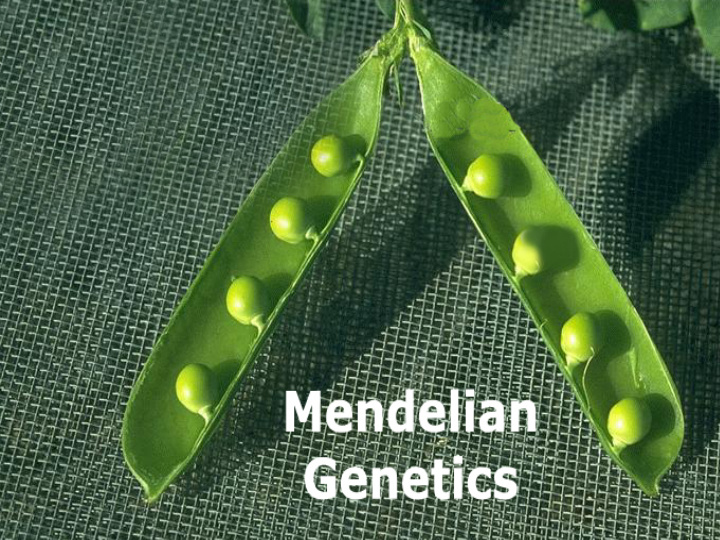



Gregor Johann Mendel • 1822- 1884 • Austrian monk • Experimented with pea plants • He thought that ‘heritable factors’ (genes) retained their individuality generation after generation Sadava, D., D. Hillis, H. Heller, and M. Berenbaum. 2009. Life: The Science of Biology . 9 th , e-book. W.H. Freeman.
Meiosis I One diploid sex cell divides…… Sadava, D., D. Hillis, H. Heller, and M. Berenbaum. 2009. Life: The Science of Biology . 9 th , e-book. W.H. Freeman.
Sadava, D., D. Hillis, H. Heller, and M. Berenbaum. 2009. Life: The Science of Biology . 9 th , e-book. W.H. Freeman. Result: One diploid cell = four haploid cells Although Mendel had no knowledge of chromosomes or meiosis, we know that a pair of alleles reside on homologous chromosomes, and that those alleles segregate during meiosis
Terms to Know and Use • Gene – A DNA blueprint controlling synthesis of a protein • Trait - variant for a gene: i.e. a purple flower, determined by alleles • Heritable trait – trait passed from parent to offspring • Dominant trait - expressed over recessive trait when both are present • Recessive trait - not expressed when the dominant trait is present • Co-Dominant – expressed as blended traits
• Allele - a variation of a gene responsible for different traits, often represented as A or a • Locus - location of a gene,or allele, on a chromosome • Chromosome - strand of DNA containing the genes • Haploid - one copy of a chromosome • Diploid - two copies of a chromosome • Gamete - a spermatozoa or oocyte (egg) cell, they are haploid
• Zygote - cell resulting from the fusion of two gametes, they are diploid • Genotype - the type of alleles on a chromosome: genetic makeup • Phenotype - The physical appearance of an organisms - way a genotype is expressed : i.e. the color of a flower • True breeding line - organisms that always pass the same genotype to their offspring • Hybrid - offspring resulting from crossbreeding two true breeding lines: F 1 • Homozygous - same alleles for a trait (AA or aa) • Heterozygous - different alleles for a trait (Aa)
Pea Characteristics Trait on the left is dominant. Trait on the right is recessive.
Mendel’s Hypotheses • There are alternate forms of ‘genes’(alleles) • For each trait, organisms have 2 genes, one from mom & one from dad • Pollen and egg each carry 1 allele/trait because alleles segregate • When only one allele is expressed & other has no noticeable effect, it is dominant • http://www.sumanasinc.com/webcontent/anisamples/ nonmajorsbiology/independentassortment.html
Mendel’s Experiments 1. Plants must possess constant differentiating characteristics. 2. The hybrids of such plants must, during the flowering period, be protected from the influence of all foreign pollen, or be easily capable of such protection. 3. The hybrids and their offspring should suffer no marked disturbance in their fertility in the successive generations. http://www.missouribotanicalgarden.org/Portals/0/PlantFinder/low/ A682-0901021.jpg
Law of Segregation When any individual produces gametes, the two copies of a gene separate, so that each gamete receives only one copy. Sadava, D., D. Hillis, H. Heller, and M. Berenbaum. 2009. Life: The Science of Biology . 9 th , e-book. W.H. Freeman.
True AA Father contributes: Breeding : P generation s A A or e produces F 1 t u generation b Aa Aa i a r t n o or c r e a Aa Aa h t o M Results in 100% offspring being: a • Genotype: Aa a • Phenotype: round-seeded • heterozygotes
Individuals from F 1 generation Sadava, D., D. Hillis, H. Heller, and M. Berenbaum. 2009. Life: The Science of Biology . 9 th , e-book. W.H. Freeman.
Cross Aa Father contributes: Breeding F 1 generation : A a s or produces F 2 e t generation u b AA Aa A i r t n or o c r a Aa aa e h t o M Results in an average of offspring being: • Genotype: 25% AA, 50% Aa, & 25% aa a • Phenotype: 75% round-seeded & 25% A wrinkled
Probablity Using Probability Sadava, D., D. Hillis, H. Heller, and M. Berenbaum. 2009. Life: The Science of Biology . 9 th , e-book. W.H. Freeman. Calculations in Genetics Like the results of a coin toss, the probability of any given combination of alleles appearing in the offspring of a cross can be obtained by multiplying the probabilities of each event. Since a heterozygote can be formed in two ways, these two probabilities are added together
Chi Squared (X 2 ) Test • Measure of ‘ how different ’ the data observed and recorded differs from the data expected 1. Determine expected results 2. Complete a goodness of fit table (O-E) 2 Exp (E) Obs (O) O-E (O-E) 2 E • Larger X 2 means more different • Theory and experiment agree less Lab manual pg. 49
Using X 2 • If the value is larger than a predetermined level (critical value) then we say that the experimental results were significantly different
Recommend
More recommend